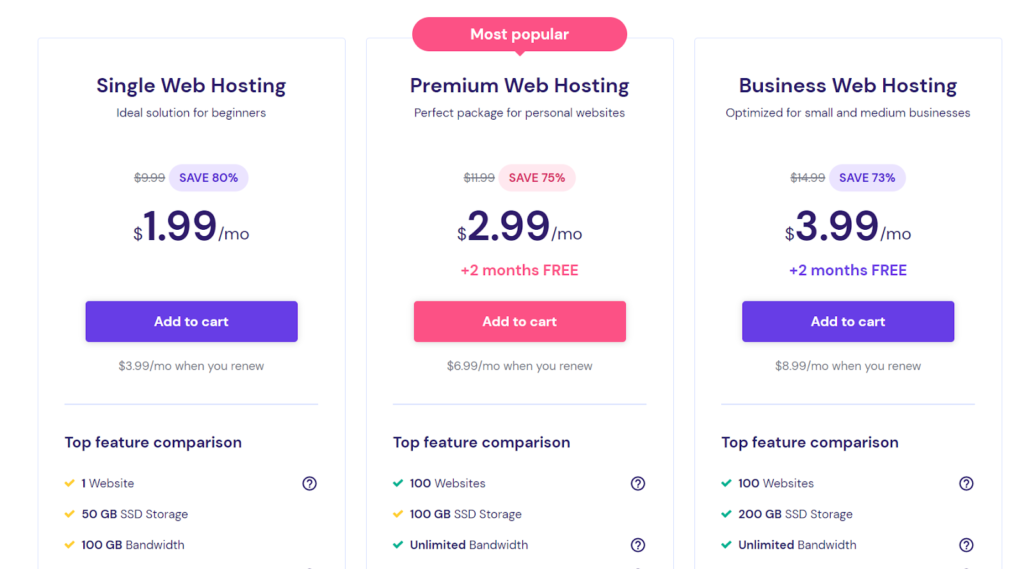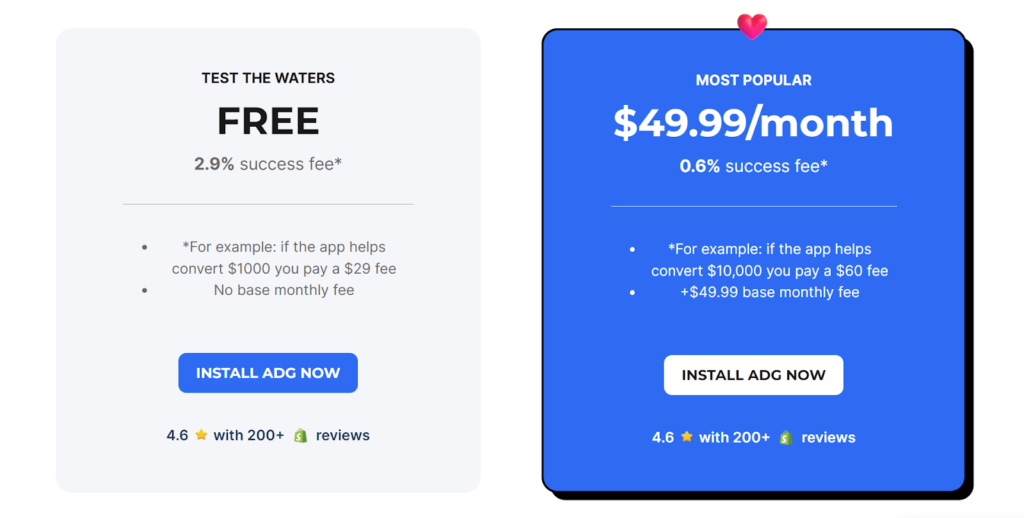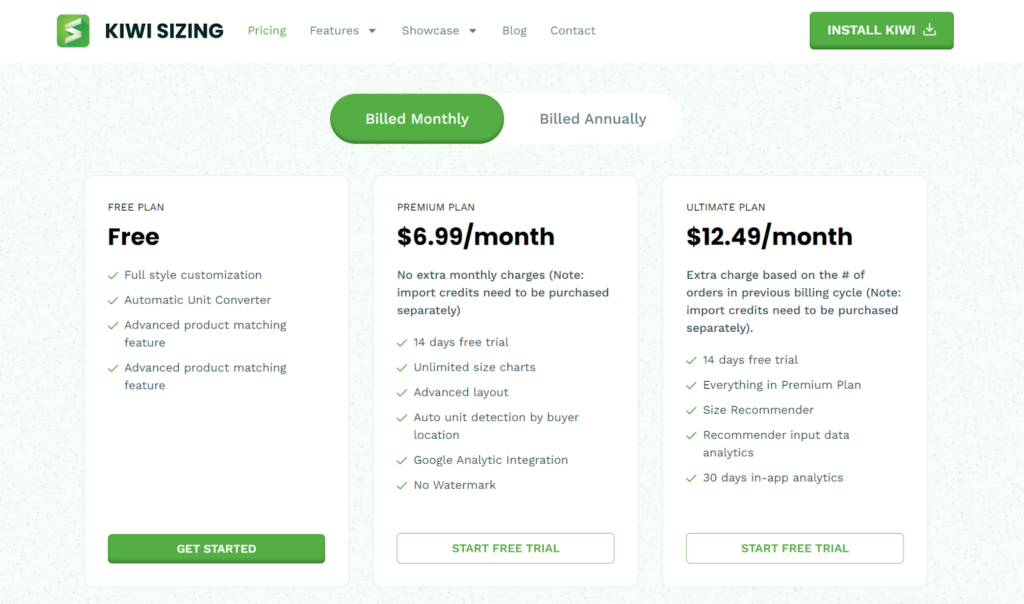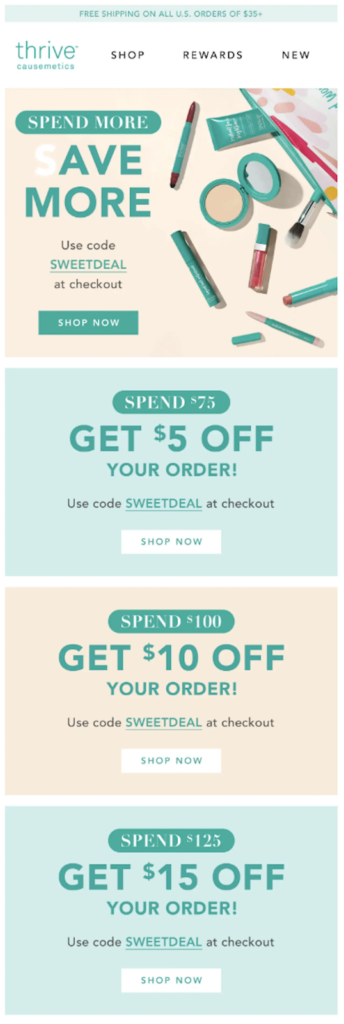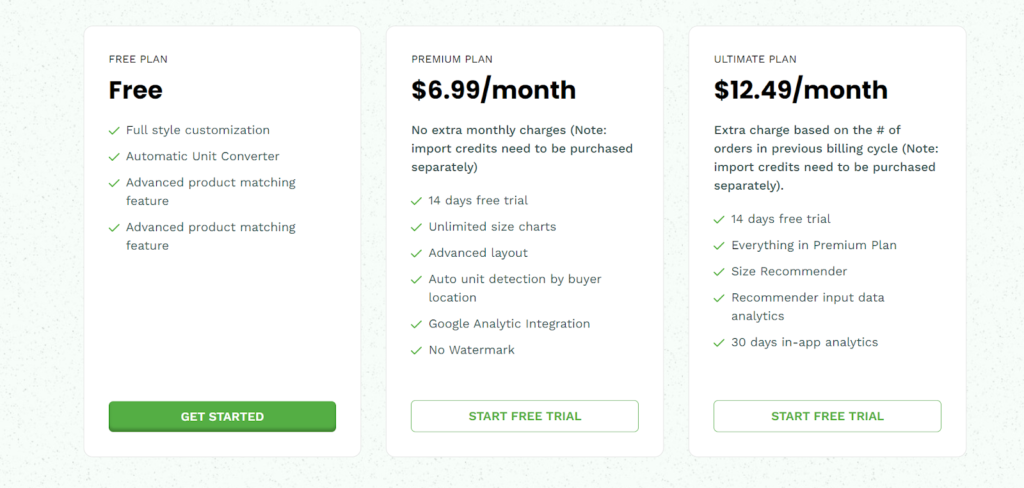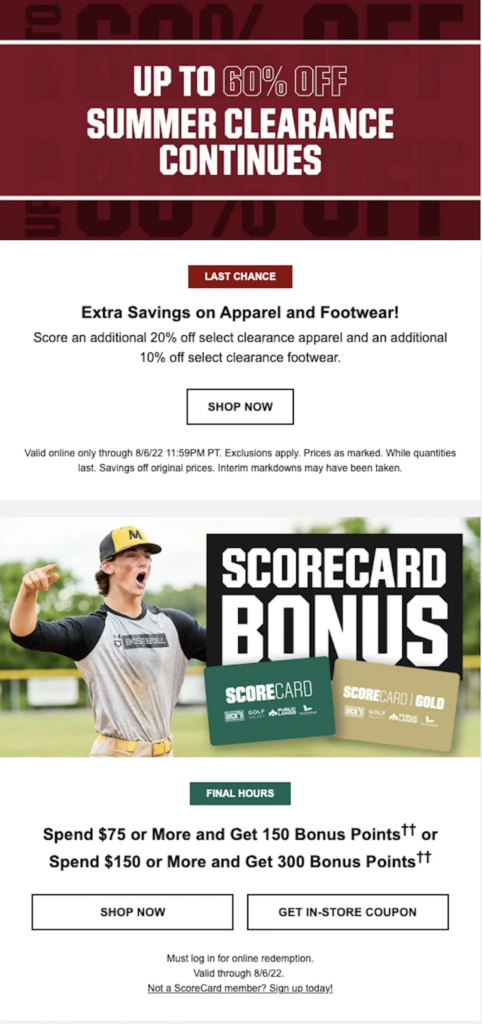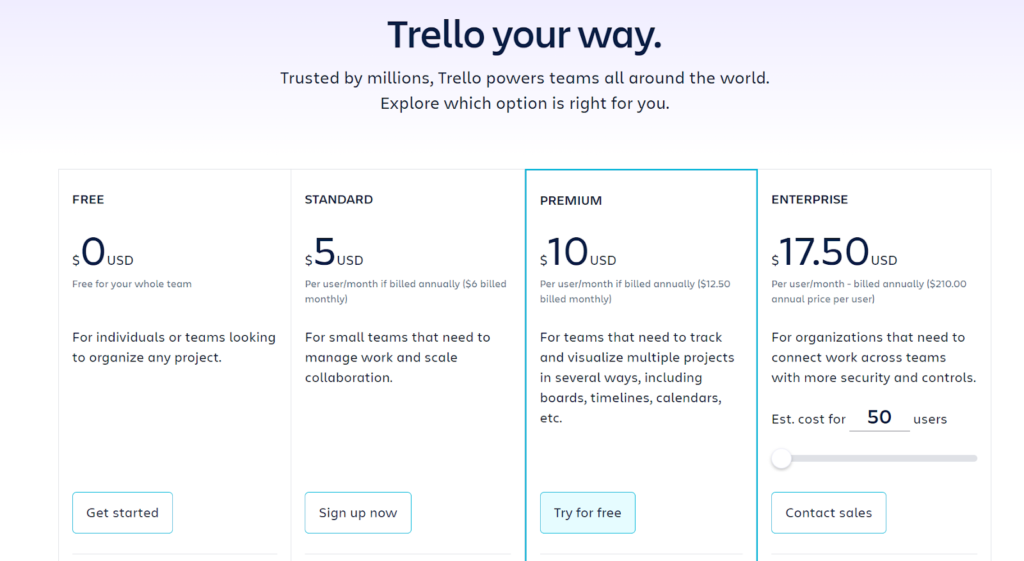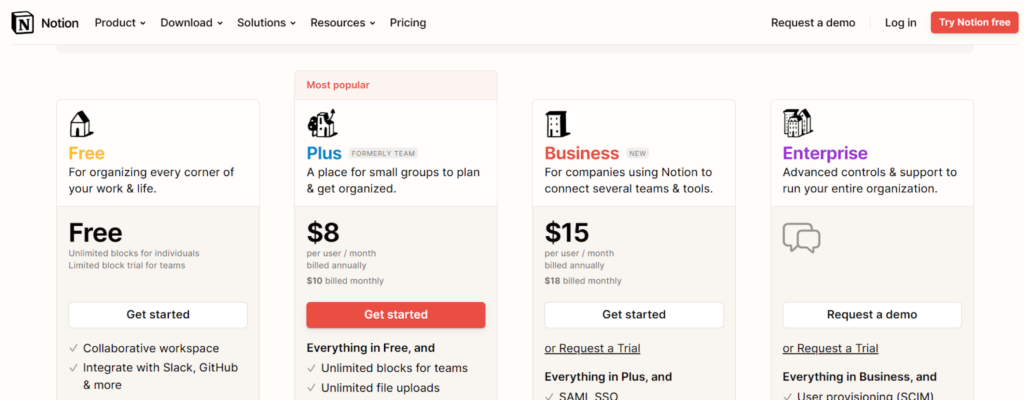Pricing is one of the most important factors for consumers. Over 60% of consumers consider price as a key factor in their purchase decisions. And offering discounts can influence these decisions even further.
80% of consumers said they were more likely to buy from a retailer that offered personalized discounts and promotions. Tiered discounts are one such powerful discount type.
Tiered discounts influence customers to buy more products to avail of higher discounts, while your store’s average order value (AOV) continues to increase. When used right, you can see an immediate boost in your AOV’s.
On Cyber Monday (and for all of Cyber Week), a great tiered promotional sale has never failed me.
— Nik Sharma (@mrsharma) September 16, 2022
If your AOV is $40, I would run:
Get 10% off $49+
Get 20% off $99+
Get 30% off $199+
Your AOV will blow up. Optimize the sale for a UPT that is friendly to your 3PL.
Let’s look at how tiered discounts work, what are the benefits of this strategy, and how you can implement tiered discounts in your business.
What is the tiered discount pricing model?
Consider Alice, a fictitious founder of Managify, a SaaS startup that provides an online project management tool for small and medium-sized businesses. She wants to grow her customer base and revenue by offering different plans that suit different needs and budgets.
She creates three tiers: Basic, Pro, and Enterprise.
- The Basic plan costs $10 per month and allows up to 5 users and 10 projects.
- The Pro plan costs $20 per month and allows up to 15 users and 50 projects.
- The Enterprise plan costs $50 per month and allows unlimited users and projects.
She adds some features that are exclusive to the higher tiers, such as advanced reporting, integrations, and priority support. She hopes that these features will entice customers to upgrade to the higher tiers when they need more functionality or performance.
This is called tiered pricing—an extremely common pricing strategy used by SaaS and ecommerce businesses alike.
Here’s a real-world example of tiered pricing offered by Hostinger, a web hosting company.
Note how they have kept it simple and highlighted the Premium Web Hosting package which automatically attracts people’s eyes when they’re planning a purchase.
But why did Alice, Hostinger, and the multitude of other companies choose tiered pricing?
Benefits of the tiered discounts model
- Increased sales: Tiered discounts incentivize customers to spend more in order to get a better deal, resulting in larger transactions and increased revenue for your business.
- Increased customer loyalty: By offering personalized discounts based on customer behavior and preferences, you can provide a more tailored and satisfying experience that can increase customer loyalty and repeat purchases.
- More flexibility: The tiered discounts model allows for greater flexibility in pricing and promotions, allowing you to offer different discounts and incentives for different customer segments or products.
- Increased average order value: Stores that offer tiered pricing have an average order value that is significantly higher than those that don’t, providing more value for each customer transaction.
- Competitive advantage: Implementing a tiered discount model can help your business stand out in a crowded market, providing a unique and effective pricing strategy that can attract and retain customers.
How does tiered pricing work?
The mechanics of tiered pricing can vary depending on the business and its products or services, but the basic principle is the same. Customers pay lower amounts as the number of units sold increases.
In the case of SaaS businesses, customers are offered pricing tiers based on the features that they need. As they upgrade to higher pricing tiers, they begin to pay lower prices per unit (for example the # of users, feature usage, or # of orders).
For example, Automatic Discounts & Gifts has two tiers: Free and paid. For Shopify stores with a higher number of orders per month, a paid plan offers almost 5x lower fees per order compared to the free plan.
The free tier helps customers get a hang of the product, understand the value it adds to their specific use case, and then decide to either upgrade or continue.
On the other hand, Kiwi Sizing, a Shopify sizing chart app has three tiers where they offer more features with each upgrade.
In the case of a retail business, you may offer tiered discounts for larger orders.
For example, a 10% discount for purchases over $50, a 20% discount for purchases over $100, and a 30% discount for purchases over $150.
This may seem very similar to volume discounts. But both tiered pricing and volume discounts work differently.
Tiered pricing vs Quantity/Volume pricing
Tiered pricing and volume pricing are both pricing strategies that charge customers based on the quantity of a product or service they purchase, but they have different ways of calculating the price per unit.
For example, if you sell packs of dog food and your tiered pricing strategy is outlined as so:
| Tier | Quantity | Price per pack |
|---|---|---|
| 1 | 1-5 | $20 |
| 2 | 6-15 | $10 |
| 3 | 16-30 | $5 |
A customer who buys 25 packs will pay $250 in total, calculated as follows:
5*$20 + 10*$10 + 10*$5 = $250
Volume pricing defines a price for all units within the range. For example, using the same example as above, volume pricing looks like this:
| Group | Quantity | Price per pack |
|---|---|---|
| 1 | 1-5 | $20 |
| 2 | 6-15 | $10 |
| 3 | 16-30 | $5 |
A customer who buys 25 packs will pay $125 in total, calculated as follows:
25*$5 = $125
Advantages and disadvantages of tiered discount pricing strategy
Both tiered pricing and volume-based pricing can be useful depending on the type of products you sell. Here are some of the advantages and disadvantages of both tiered and volume pricing.
| Tiered pricing | Volume pricing | |
|---|---|---|
| Advantages | Attracts customers who may be unable to pay standard-priced packages. Leaves room to upgrade when they’re satisfied with the service or their requirements expand. Makes it possible to align the value you provide with the amounts customers pay. | Simpler to calculate and communicate. Encourages customers to buy more and get discounts. Creates a sense of fairness and transparency among customers who pay the same price per unit. |
| Disadvantages | More complex to calculate and communicate. Potentially discourages customers from buying more than they need. This creates confusion or dissatisfaction among customers who may feel they are paying too much for certain units. | May lose revenue from customers who are willing to pay more. May price out customers who are not ready to buy in large quantities. May not reflect the value or cost of providing different units. |
To implement tiered pricing effectively, you need to carefully consider their pricing structure and the thresholds for discounts. The tiers must be designed based on what you learn from your customer’s usage of your products.
How to plan tiered discounts for your business?
Let’s take a look at how Alice, our fictitious founder of Managify decided to create her tiered pricing plans:
- For her project management app, there are two most important variables—the number of users and the number of projects. Alice decides to use these as a way to segment her users.
- She creates three tiers: Basic, Pro, and Enterprise. The Basic plan costs $10 per month and allows up to 5 users and 10 projects. The Pro plan costs $20 per month and allows up to 15 users and 50 projects. The Enterprise plan costs $50 per month and allows unlimited users and projects.
- As a user upgrades to higher tiers, their price per user and per project goes down. This encourages more users to upgrade to higher tiers while also allowing people with lower usage to continue using Managify.
To understand the last point better, take a look at this example.
In the Basic plan for $10 a month, each of the 5 users costs $2/user/month and the projects cost $1/project/month. But in the Pro plan at $20 a month, each of the 15 users costs $1.3/user/month while the 50 projects cost just $0.4/project/month.
Real-world examples of tiered discounts and pricing
To get a better understanding of tiered pricing and discounts, let’s take a look at some of the examples in the SaaS and ecommerce space.
1. Thrive Causemetics
Thrive Causemetics is a vegan and cruelty-free cosmetics brand that donates to women in need for every product purchased. Thrive Causemetics offers high-performance makeup and skincare products that are formulated with clean ingredients and innovative technology.
One of their recent promotions was the Spend More Save More Tiered Discount, which offered different levels of discounts depending on how much customers spent on their online orders. The tiers were as follows:
- Spend $75 or more and get $5 off
- Spend $100 or more and get $10 off
- Spend $150 or more and get $15 off
This tiered discount strategy was designed to encourage customers to shop for their favorite products and try new ones at a lower price. It also created a sense of urgency and exclusivity, as the promotion was only valid for a limited time and for online orders only.
2. Kiwi Sizing
In the case of SaaS businesses, the value is conveyed through the additional features per upgrade. For example, Kiwi’s free plan enables size charts but adds an attribution/watermark to their size charts. Also, this plan offers the most basic features required for customers to get up and running.
The Premium and Ultimate plan offers advanced features like automatic unit detection based on the buyer’s location, unlimited size charts, and AI-powered size recommendations.
This additional value comes at a small monthly price. Ecommerce stores with a higher number of sales can use these features to offer better customer experience and thus improve customer retention.
3. Dick’s Sporting Goods
Dick’s Sporting Goods is a leading sporting goods retailer that offers a wide range of products for sports, fitness, outdoor recreation, and fan gear. Dick’s Sporting Goods also runs a loyalty program called ScoreCard, which rewards customers for their purchases and activities. ScoreCard members can earn points, rewards, and discounts at Dick’s Sporting Goods and its family of brands.
Dick’s ran a tiered discount on their clearance products at 20% on selected apparel and 10% on selected footwear products.
Apart from that, they also included bonus points for Scorecard members for spending above $75 and $150. Since the bonus points can be converted to cash rewards at 300 Points = $10 Reward, regular customers will be more inclined to make higher purchases.
Best practices for running tiered discounts
Tiered discounts give customers different levels of discounts based on how much they buy or spend. They can help businesses increase sales volume, customer loyalty, and average order value. Here are some best practices for implementing tiered discounts effectively:
- Design tiers based on buyer personas. Understand what types of customers will be attracted by which tier, and then design the offering and pricing based on your understanding of that hypothetical customer. For example, if you sell software as a service (SaaS), you may have different tiers for small businesses, medium businesses, and large enterprises, with different features, usage limits, and support levels for each tier. Trello does it well by defining which persona should opt for a specific tier.
- Avoid overwhelming your users with too many tiers. Try to stick to 3-4 tiers, as more than that can confuse customers and make them indecisive. You can also use names that are simple and self-explanatory for each tier, such as Basic, Standard, Premium, or Ultimate.
- Present a “preferred” plan to give your users a much-needed push. You can highlight one of your tiers as the most popular or recommended option for most customers, and use visual cues such as badges or colors to draw attention to it. This can help customers make quick decisions and increase conversions. You can see Notion highlights their $8/user/month plan as the most popular one.
- Use anchoring to highlight additional features in higher-tier plans. Anchoring is a psychological phenomenon where people tend to rely on the first piece of information they see as a reference point for making comparisons. You can use this to your advantage by showing the highest-tier plan first, followed by lower-tier plans with fewer features or benefits. This can make customers perceive the higher-tier plan as more valuable and worth paying more for.
- Emphasize easy upgrades (or downgrades) from one tier to another. Customers may change their needs or preferences over time, so you want to make it easy for them to switch between tiers without any hassle or penalty. This can increase customer satisfaction and retention, as well as upselling opportunities. Here’s a tiered discounted pricing strategy by Vultr where they help you easily upgrade or downgrade your server instances based on your requirements.
- Make sure no two tiers are too close in terms of pricing or features. If two tiers are similar in the value proposition, customers may not see the benefit of choosing one over the other. You want to create clear differentiation between each tier by offering significant discounts or additional features that justify the price difference.
How to create tiered discounts on Shopify?
Now that you understand what tiered discounts and tiered pricing are, let’s see how we can create these discounts on Shopify.
The default Discounts feature of Shopify does not offer a straightforward way to create tiered discounts. You may have to create a set of multiple “Amount off” discounts to create tiers. An easier method is to go for an app like Automatic Discounts & Gifts. This app extends Shopify’s existing discount functionality and makes it much more powerful and customizable.
Step 1: Install ADG on your store
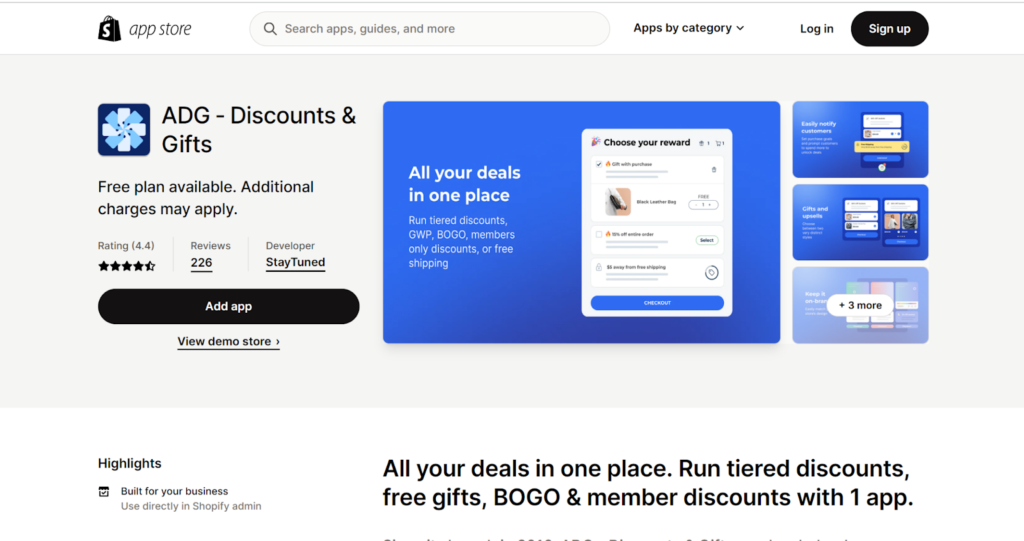
Go to the Shopify app listing for Automatic Discounts & Gifts.
Click Add App and proceed with the steps to complete installation.
Step 2: Go to the app discounts creation page

Click on Apps from the bottom left of your screen. It should open up the search bar. Enter ADG and you’ll be taken to the app dashboard.
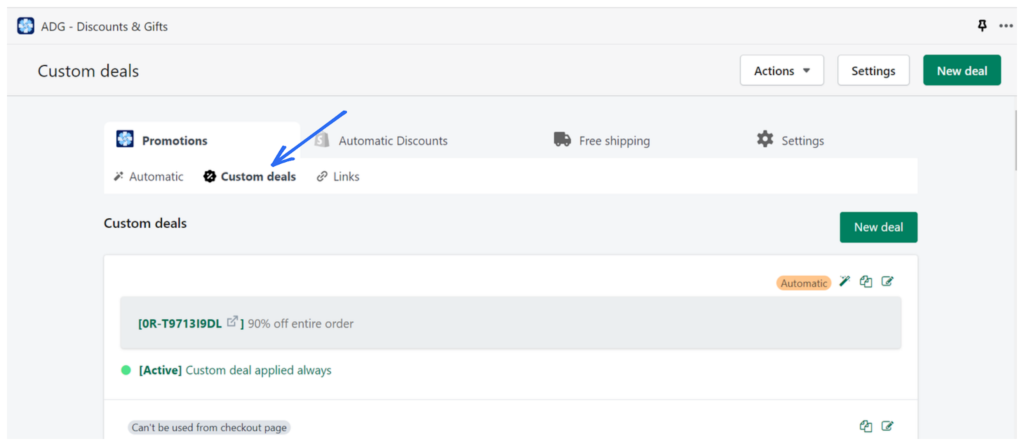
Step 3: Create the tiered discount on Shopify
Then, click New Deal to be presented with the discount type choices. Pick Tiered discounts and scroll down to customize the options.
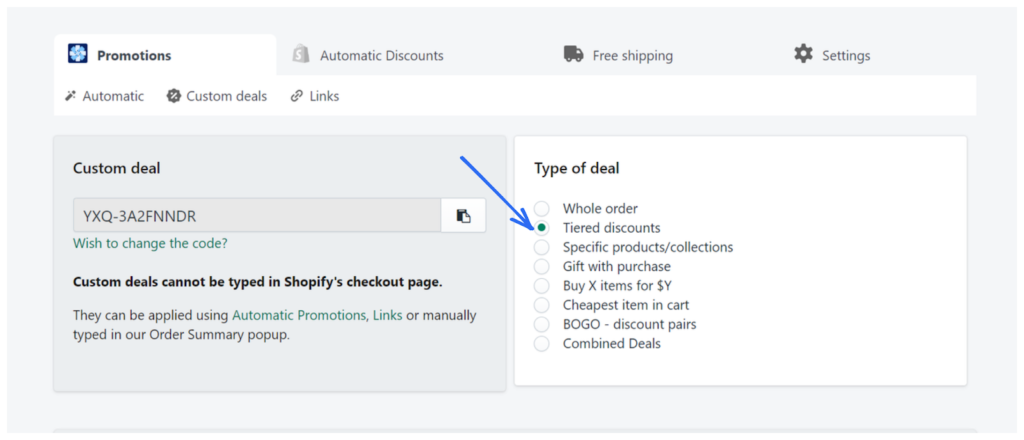
Here, you can add multiple tiers to the discounts by clicking on the Duplicate benefit button. Each additional discount can be configured independently.
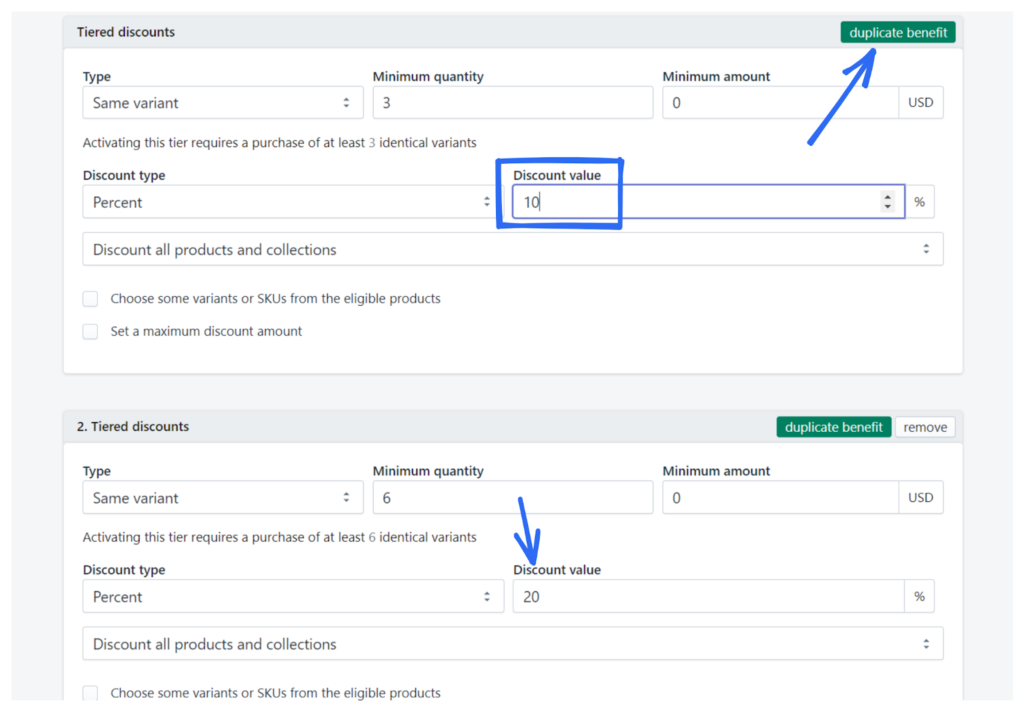
Once the discounts are set up, scroll down for further optional settings. You can also add additional requirements like minimum cart value, usage limits, and others.
After you’ve configured your discounts, click Create deal and your tiered discount will now be live on your website.
Create a banner on the website to announce the discount to your customers increasing your store revenue with minimal added effort!
Earn more from your store with tiered discounts, today
Tiered discounts are a popular pricing strategy used by businesses to incentivize customers to spend more while offering personalized and flexible discounts.
After analyzing the advantages and disadvantages of tiered discounts, it is clear that this pricing strategy can be beneficial for businesses. It can lead to increased sales, customer loyalty, and average order value while providing a competitive advantage.
To make setting up tiered discounts on your store easier, try Automatic Discounts & Gifts. It allows you to set up an unlimited number of custom deals right from your Shopify dashboard. The app is designed to extend Shopify’s default functionality and make it more powerful with conditional discounting, custom BOGO offers, and much more.
As businesses continue to evolve their pricing strategies, it’s worth asking: how can we strike the balance between offering personalized discounts and maintaining a fair and transparent pricing structure for all customers?

